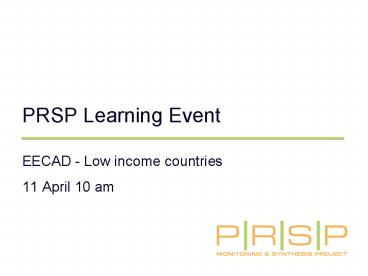PRSP Learning Event - PowerPoint PPT Presentation
1 / 15
Title: PRSP Learning Event
1
PRSP Learning Event
- EECAD - Low income countries
- 11 April 10 am
2
Origins of the PRSP Initiative
- Poor record on poverty reduction in the 1990s
- Findings on aid effectiveness and limits of
traditional conditionality - Justification for increase in multilateral
funding through debt relief
3
PRSP Principles
- Key principles
- Country-led and ownership increased through
participation - Comprehensive - macro, structural, social
- Medium to long term perspective
- Outcome-oriented, based on analysis of poverty,
and prioritised - Donor partnership under government leadership
- What is new about this?
- Linking macro and fiscal framework to PR strategy
- costed strategy - Opening up policy process to broad based
participation - Opportunities for new ways of delivering aid
4
Context matters
- No cookie cutters!
- Low-income transition countries have specific
features - Weak history of evidence-based policy making
- Lack of civil society participation
- Lack of familiarity with international aid
community - but rising levels of debt. Different
players than other regions. - Poor governance environment, with several
countries affected by conflict - Country-specific politics- elections, parties,
conflicts
5
Expectations - Ownership
- National poverty reduction strategy more likely
to succeed if supported by broad based ownership - Broad based ownership more likely if civil
society and the poor influence policies - Accountability to citizens strengthened, thereby
reducing poverty (where related to weak
governance and poor service delivery record) - Technical benefits too policies to benefit the
poor are more readily identified (though danger
of shopping lists)
6
Experience - Ownership
- Ownership of externally driven process?
- MoF involvement key - difficulties with line
ministry involvement (Tanzania, Rwanda) - Weak capacity for process across govt. (Albania)
- PRSP ideally builds on existing nat plans -
augmenting with more participation, linking to
resource envelope, and results orientation.
(Nepal) - Importance of working with existing dynamics -
including political dynamics (Moldova)
7
Experience - Participation
- Some opening of policy space in country -
fragile - Generally limited to consultation with limited
feedback to CS - Broadly similar formats local, regional,
national workshops, plus some PPAs (Ethiopia)
Parliaments not generally involved - Strong advocacy of some key themes but not on
macroeconomic policy (Kenya) - Very high expectations on the part of civil
society - some bitter disappointments (Kampala
declaration, PRSP Review)
8
Country examples
- Kenya - very positive participatory process
despite lack of high level political commitment
and poor governance environment - Bolivia - legal framework for participation
established in the National Dialogue Law - Albania - GoA needed convincing of merits of
participation - achieved through training of
officials active collaboration of PRSP
Secretariat across ministries - Vietnam - High quality PPA underpinned
consultation linked to ongoing process of
national policy formulation
9
Links with resource envelope
- Budget and MTEF
- Key lesson is to move on these in parallel with
the PRSP - Constrained fiscal choices in CIS means spending
must be limited - but some budget process
measures can have pro-poor impact - PEM/PER
- Tanzania - good example of nesting the PER
process within the overall PRS process - Watch for over-optimistic growth forecasts
(Bolivia) - Is donor financing on budget? (TA in Nepal)
10
Results orientation
- Policy making based on analysis of needs - but
there are serious gaps in data in many cases (and
data gathering capacity) - Missing middle - lack of concrete steps from
analysis to interventions - Feedback of ME and PSIA into future iterations
of PRSP (inc Annual Reports) - needs
institutionalisation - (Somewhat covert) expectations around
participation in this area - PPA and civil
society monitoring of implementation. Need to
stimulate demand for information
11
Results orientation 2
- Vietnam Development Targets - country-specific
version of the MDGs, established in DFID-financed
workshop with civil society and donor
participation. Intermediate benchmarks to measure
progress. (Also PPA mentioned earlier) - Uganda - UDN involved in public expenditure
tracking at local level - Bolivia - Bilat Coop Network identified need for
indicators and targets in the area of
institutional development
12
Donor behaviour
- Leading edge DFID thinking in this area
- lower transactions costs - harmonisation
- streamlined conditionality
- predictable aid flows
- transparency of operations
- untied aid
- general budget support
- donor obligations on aid
- external assessment of partnership
13
Donor behaviour 2
- Perhaps agenda not realistic where DFID not a big
player and where big players are unsympathetic - Coordination can take place without common
financing mechanisms (Georgia) - Projects and SWAps - can support the PRSP
- Is direct budget support an option? Risks and
safeguards - Are there opportunities to influence the agenda
in these countries?
14
For discussion
- What is relevant for LICs in transition?
- What is already happening?
- How can DFID feasibly and constructively support
the processes of change implied by the PRSP
agenda? - Ownership
- Participation
- Results-orientation
- Other donors
15
PRSP Schedule
- Key Events
Preparation Status Report
1st Annual Progress Report
2nd Annual Progress Report etc..
I-PRSP
I-PRSP
PRSP (I)
PRSP (II)
9-24 months
2-5 years
- PRSP elements
- Poverty analysis
- Goals/targets
- Policy actions
- ME plan
- Med-term budget fw
- Financing plan
- External assistance
- Participatory process
HIPC(II) Completion Point
HIPC(II) Decision Point































